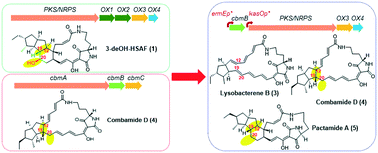Construction of a hybrid gene cluster to reveal coupled ring formation–hydroxylation in the biosynthesis of HSAF and analogues from Lysobacter enzymogenes†‡
Abstract
HSAF and analogues are polycyclic tetramate macrolactams (PoTeMs) isolated from Lysobacter enzymogenes. Due to their antifungal activity, distinct chemical structure and new mode of action, PoTeMs have been the subject of several studies for their biosynthetic mechanism. However, polycycle formation is still not well understood. HSAF and several analogues (alteramides) carry a C20–hydroxyl, which is absent in most known PoTeMs such as combamides and pactamides. Previous studies indicated that two genes encoding NAD(P)H-dependent flavin enzymes (OX1/OX2) are responsible for the second five-membered ring formation in HSAF and alteramides. Intriguingly, the products of OX1/OX2 always carry the C20–OH. To test the hypothesis that the formation of the second five-membered ring is coupled with the C20-hydroxylation, we constructed a hybrid PoTeM gene cluster through removing OX1/OX2 in the HSAF cluster and functional complementation by CbmB, which also catalyzes the second five-membered ring formation in combamides but lacking the C20–OH. Two heterologous hosts carrying the hybrid cluster generated the same three PoTeMs, including lysobacterene B (3, the one-ring precursor of HSAF) and combamide D (4, a two-ring product lacking the C20–OH). The third product was not related to either of the clusters and was identified to be pactamide A (5) using mass spectrometry, 1D- and 2D-NMR, and ECD spectroscopy. The results demonstrate the feasibility of producing new PoTeM compounds through combinatorial biosynthesis. More importantly, this study provides the first experimental evidence to support that the second ring formation is coupled with the C20-hydroxylation in the biosynthesis of HSAF and analogues.

- This article is part of the themed collection: Natural Products


 Please wait while we load your content...
Please wait while we load your content...